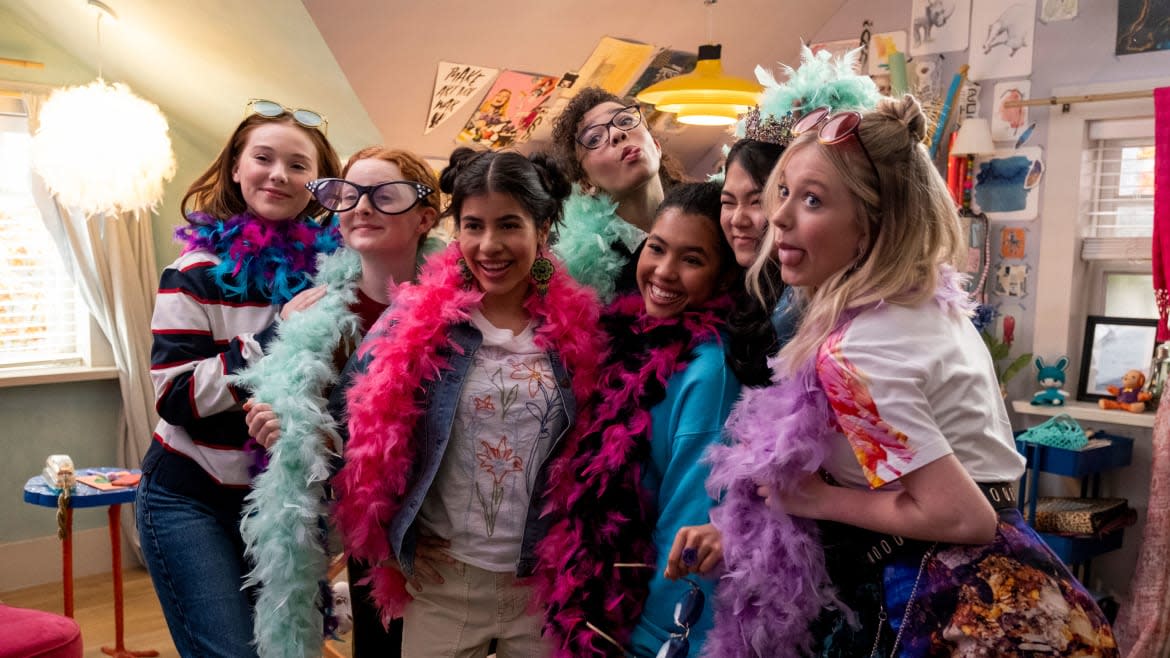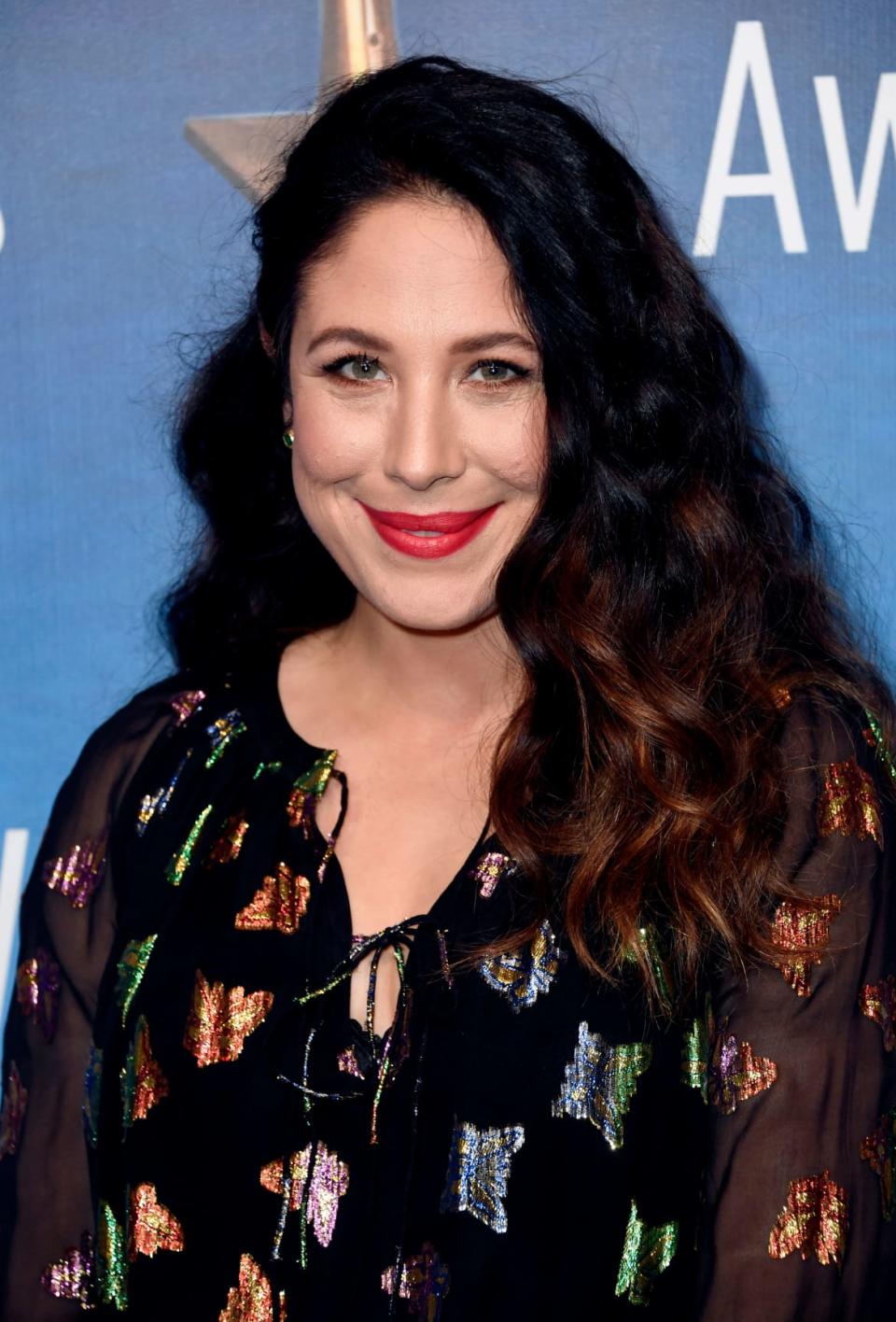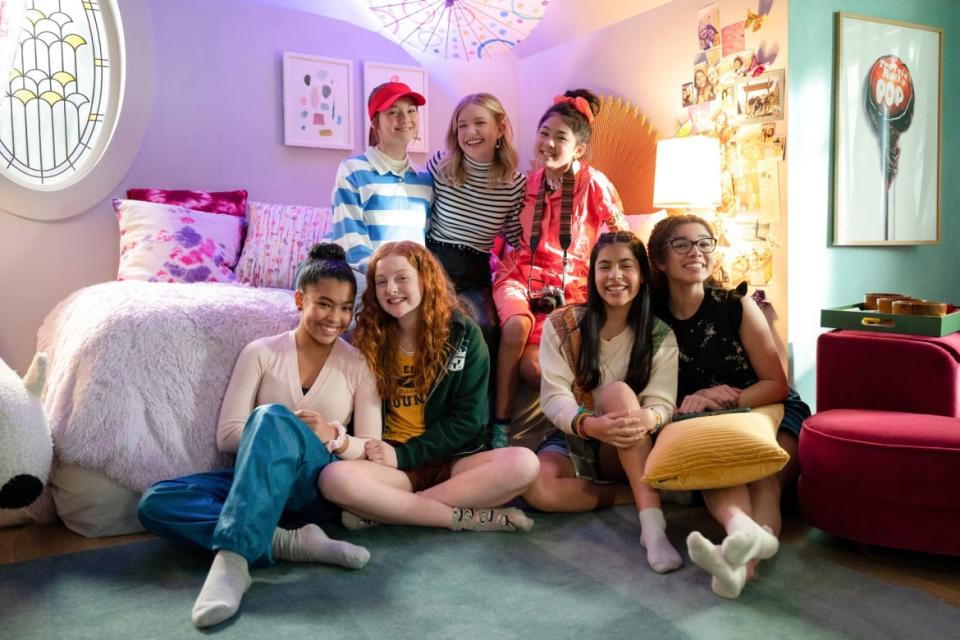The Secrets of the Best Show on TV Right Now: ‘The Baby-Sitters Club’

The Netflix adaptation of The Baby-Sitters Club is TV’s coziest warm hug.
It is finding the color butterfly clip for your hair to perfectly match your outfit. The heart used instead of the dot on “i.” The rush of excitement when your crush circles “yes” on a passed note that reads, “Do you like me?” It is finding a group of best friends and knowing that, no matter what, they understand and are there for you.
So, color me shocked to discover when watching the second season of the series, which premiered last week on Netflix, that, this go-round, The Baby-Sitters Club chose violence.
In the fourth episode, “Jessi and the Superbrat,” new club member Jessi (Anais Lee) is at ballet class. During a voiceover, she says, “One day, my mom was playing this old song, ‘Always Be My Baby’...” As in the Mariah Carey hit. From 1995. I’ve never so passive-aggressively been called “old” before.
“I found it a little violent when I read it in the script, too,” series creator Rachel Shukert tells The Daily Beast when confronted on behalf of all millennials and members of Gen X who may have been traumatized while watching her show. (She was also, it must be said, laughing.) “But it is an old song for [Jessi]!”
The other day, Shukert was listening to the “90s on 9” station on Sirius XM and had an epiphany. “I was like, ‘Oh my God these songs are as old as the oldies station that I used to listen to in high school, where everything was from the ’60s. Horrible.”
Adele’s New Song ‘Easy on Me’ Is Even More Devastating Than We Thought
The intense reaction to feeling geriatric while a modern tweenage character talks about ’90s pop culture, does, however, zero in on a bit of the phenomenon behind The Baby-Sitters Club. In a way that has taken certain members of the media by surprise—this writer included—the show, a young adult series in every way, has exploded outside of any niche appeal some might have expected.
Consistently in Netflix’s Top 10 list since its premiere last week, the series isn’t just being watched by young girls and middle schoolers one would assume would be the target audience of a winningly pure and empathetic—and G-rated—show about a group of best friends navigating their coming-of-age alongside the responsibilities of their baby-sitting business.
Among adults, it even extends beyond the devoted fans of the Ann M. Martin book series the show is based on, like those with fierce memories of Kristy, Claudia, Dawn, Stacey, and Mary Anne who watched out of nostalgia or devotion.
It might have started with that group, who remember fantasizing about their own lives in Stoneybrook eating Twizzlers with the girls and somehow being entrusted with the lives of other people’s children despite being children themselves, just 13. They watched and spread the world: Guys, this is actually really good. Then the mainstream critics got involved—which, let’s be honest, is overwhelmingly straight men—and suddenly the Rotten Tomatoes score spiked to a flawless 100 percent.
I watched the episodes in one sitting during the pandemic last summer and became a missionary. I only wanted to talk about The Baby-Sitters Club. No one had been here for me in those trying times like my girls. No one made me feel safe. Feel sane. Feel at peace. Feel OK to be me... to just FEEL... like those girls. My friends. The Baby-Sitters Club.
It wasn’t just a show that was nice. Without raunchy jokes, punchline writing, pandering plot twists, or salacious Very Special Episodes, the show was good. It was the thing no one saw coming: This “kids’ show,” if we’re going to be reductive, ranked among the best on TV, and adults—of all kinds—were finding it. At a time when it’s a struggle to get anything to hit (think of Baby-Sitters Club as the anti-Squid Game), how did this series, of all things, be one of the few to do it?

Rachel Shukert
Shukert admits to being taken by surprise at the series’ crossover appeal. She assumed the young audience would be in, and she was banking on the women who grew up on the books to watch because, as a fan of them herself, she would have too if someone else had revived the series.
But to explain the appeal of the series to adults, she says that, having previously worked on Netflix’s GLOW and Cursed, she just made the show she knew how to make: “I didn’t know how you were supposed to make a show for kids as opposed to a show for adults.” She laughs, but maybe that’s the secret sauce.
That’s not to say that there weren’t fears that the series would be pigeon-holed. This is a show about an ensemble cast of 13-year-old girls. They talk about boys and clothes. There’s a lot of the color pink. Episodes chronicle things like one club member getting overwhelmed while staging a charity fashion show, or another feeling awkward after she gets her first boyfriend. In the season one finale, Kristy gets her first period at her mother’s second wedding.
“Stuff that’s made for girls, and specifically girls in this age group, is often devalued against stuff that is made for boys,” Shukert says. “I feel like all these things that are made by male creators about what they loved in middle school—comic-book movies or superheroes or Star Wars or whatever—are treated like they’re Hamlet.”
When it’s about the interests of girls at that same formative period, “it’s treated more as fluffer and more disposable.”
Her goal with The Baby-Sitters Club was to respect it as the foundational text for a generation of women that it was, and then lend that the same seriousness that these other male-oriented properties are given. After all, for the amount of times creators of female-centric programming are asked by marketing teams in a panic about “crossover appeal” for men and boys, how often is the question posed in the other direction?
There is, however, relief in the evidence. Season 1 worked. The reviews were ecstatic. Fans of the book didn’t just feel like the show did the texts justice; they once again, decades later, felt seen by these characters and the message they carry. It even won awards: a Television Critics Association Award for Outstanding Achievement in Youth Programming and a Daytime Emmy for Sophie Grace, who plays Kristy, plus a nomination for Alicia Silverstone who plays her mother.
It’s made Shukert a bit more relaxed. “Now we can actually lean into the girliness of it a little bit in the marketing. I don’t have to worry about the fact that this poster wasn’t shot in dramatic lighting by Annie Leibovitz. People are going to be okay with it, even if it has candy and friendship bracelets on it. Which it should!”
That’s the thing about The Baby-Sitters Club that may be remarkable. In the years since millennials first picked up Martin’s books, there have been female characters on children’s TV. (Ever heard of Hannah Montana?) But there’s a major difference between the multi-cam, laugh-track sitcoms that were popular on The Disney Channel, for example, and a show like The Baby-Sitters Club that, while funny, mines its humor from these characters’ personalities and existence. No one is hamming for the camera, or mugging for a joke.
Then there’s the characters themselves. Identifying which Baby-Sitters Club member you are may be as informative as a person’s Zodiac sign or Myers-Briggs result. Kristy is the ambitious leader. Claudia is the creative one. Dawn is rebellious. But they’re also all, very plainly, 13-year-old girls.
“In the YA space, when girls are the main characters, they always go out of their way to be like, ‘Well, I’m not a girly-girl like other girls. I don’t care about clothes. I don’t care about boys,’ Shukert says. “In The Baby-Sitters Club, they were allowed to care about those things and it didn’t make them less important or give them less gravitas because they cared about things like girls care about.”
Even the temptation to write off things like a middle-school girl’s angst or obsession over clothes is a little demeaning. When girls care about clothes, it’s presented as shallow. But the truth is, at the age of the characters in the show, how someone dresses is as much about finding out who they are and how they want to be perceived by the world as it is about labels and fashion. That’s actually profound, but so often dismissed.
But it’s also not just about aesthetics. In some respects, this is a series about a universally shared experience. We’ve all been to middle school. For some of us, that entails a certain PTSD that haunts us every day. Maybe, then, the unbreakable bond of these friends is a bit utopian. Even if that’s true, their experiences, milestones, stressors, and, most of all, feelings, are treated with dignity.
In that way, The Baby-Sitters Club almost feels like a product of a forgotten era. It’s a series marketed to tweens that is actually age-appropriate and features no Archies, Betties, or Veronicas having threesomes or solving gruesome murders.
It’s also deep. Turns out distilling emotions to the stripped-down versions of what you felt as you were becoming an adult makes them all the more meaningful. The show assumes you have the emotional intelligence and the compassion to deeply empathize with girls who are dealing with the daily chaos of friendship and tweenage existence. Nothing is overly explained, just dramatically experienced.
These are big emotions and massive feelings that we’re dealing with, too—and in characters at an age when everything feels so untenable, so catastrophic. This season, there is grieving over a family member’s death, a possible divorce to reckon with, and the realization that someone who abandoned you has deeply hurt you, and may not deserve your grace. You will watch as a grown-ass man (not speaking from personal experience or anything…) and cry.
Shukert posits that this is because those feelings and how we deal with them don’t really change as we get older. A 13-year-old then or a thirtysomething now doesn’t know what to do with that kind of loss or disappointment. You don’t feel more or less unmoored by it just because you’ve gotten older.
There’s an earnestness about The Baby-Sitters Club that is a pleasure to watch. At a time when “earnest” and “nice” is alternately celebrated and reviled—the Ted Lasso conundrum—it’s figured out that identity, much of which carries over from the spirit of Martin’s books. Shukert says the books are about friendship, sure, but also about responsibility. “And I don’t mean that in the way that sounds like a drag, like doing your homework.”
The girls in the club want to be role models. They take that seriously. They want to do things for others, be caring, and be valuable assets to their community. They are babysitters, and they think of that as being of service. That stands out in contrast to what we see about that age group in literature today.
“None of these girls have to save the world in a massive, dystopian teen-fiction way,” Shukert says. “None of them are ‘The Chosen One,’ the only person that can topple the totalitarian society that has sorted everybody according to Zodiac sign, or whatever, and pitted them against each other. It’s all on this very human scale. You can make a difference by leading the rebellion, or you can make a difference by making a scared, sick kid feel better while you’re waiting for the doctor to come.” (A reference to a gorgeous Mary Anne-centric episode from season one.)
Shukert and her collaborators were conceiving the show in 2018. Of all the dark news at the time, she remembers being really affected by the border separations that were happening between parents seeking access to the U.S. and their children. It felt dark and insurmountable. It still feels that way.

“I was thinking about what you can show this audience that says you cannot fix everything that is out of your power, but also asks what is like one small thing you can actually do to help somebody or make yourself feel less powerless?” she says.
There is one more secret to the show’s resonance, something that may be the most transgressive of all. The actresses cast as 13-year-olds actually look like 13-year-olds, because, when the show began, they were. And here’s the startling thing about that, after decades of watching actors in their late twenties and thirties play teens on TV: That is young. They look like children. Because they are! That’s key.
Sure, you wonder how much of that innocence on screen is delusional. Yes, 13 is young. But it is also when kids start to be seduced into more adult behavior and content. But even that reality is reflected on the show.
“I remember when I was in middle school, there were kids that were already experimenting with drugs and sex, and there were kids who still played with Barbies,” Shukert says. “And sometimes they were the same kids. One of the things that’s interesting about the group dynamics in The Baby-Sitters Club is that they are all at different levels of maturity but they’re still friends. Someone like Stacey is a little more ready for some of that stuff, even if we don’t necessarily show it. Someone like Mary Anne or Kristy is not.”
And if, after watching, you have the unshakable desire to cocoon these sweet young girls and somehow freeze them in time at this age, with these morals and that innocence, in order to protect them from the cruel, unforgiving world that awaits them as they grow up, you are not alone. Shukert understands. But she has faith in these girls, and the values the club instilled in them.
“They’re right on the cusp of that time in your life where you’re still, like, who you really are, before you get to high school [and] you suddenly are getting all of these peer signals about how you’re supposed to act that are often at odds with who you really are inside,” Shukert says.
Personally, she feels like she’s much closer now to the personality she had at age 13 than when she was a teenager. As you grow up, you have to unlearn all that “teenagerness” in order to get back to who you really are. “You see people go through this stuff in high school, and if we follow these characters through high school, you would probably see some of that. But I also have faith that they’ll kind of return to their core selves.”
If you’re a Kristy once, you’re a Kristy forever.
Get our top stories in your inbox every day. Sign up now!
Daily Beast Membership: Beast Inside goes deeper on the stories that matter to you. Learn more.

